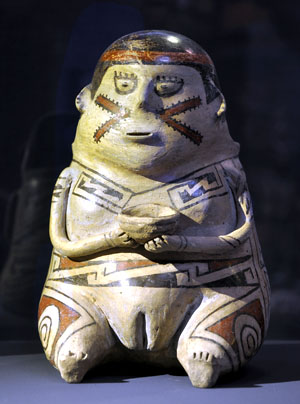Mata Ortiz Pottery

A Ramos Polychrome figure
A lot of the story of modern Mata Ortiz is based around the story of Juan Quezada. The story of Juan Quezada is part marketing fabrication and part reality. His story is similar to that of the Ortiz brothers, working at the same time to get to the same end but working at the other end of the village. There are others (of the Silveira, Ortiz, Olivas, Ledezma and other families) who were hanging around nearby and sometimes getting into the action. All of them had dug and/or had made antiqued pots. They needed to get over that hump and get into the modern market. The full story of Mata Ortiz pottery has to include them all, including Manuel Olivas who was producing antiqued pottery in Nuevo Casas Grandes since the early 1950s. Virtually all of the earliest Mata Ortiz potters connected with Manuel at one time or another, including Juan Quezada.
The marketing story was invented by Spencer MacCallum, an American dealer who stumbled across three of Juan Quezada’s pots in a shop in Deming, NM in 1976. He traced them back to Juan and for several years, he had an exclusive contract to represent Juan’s pottery everywhere. In furtherance of that project, they put together the story:
Juan was a young farmer who helped the family out by gathering firewood and tending to the family cattle. Everywhere he went in the countryside, he was seeing ancient potsherds in the dirt. They interested him enough that he dedicated more than a decade to discovering and refining the ancient processes for making those pieces of pottery (as whole objects, of course). Most of his process he may have come up with himself but some info he got from Manuel.
Eventually Quezada was successful in his quest. He learned to use sand and other coarse materials for temper. He discovered that dried cow dung made an excellent and inexpensive firing fuel. Instead of using gourds for smoothing he substituted broken hacksaw blades. Instead of using yucca fiber brushes for painting he learned to make brushes with human hair. He persevered in his efforts and by 1971 had produced a kind of polychrome pottery. Since then, most pottery-making in the area has used innovations in the design and decoration of the pots but the materials and the basic crafting of the process have remained the same.
By the mid-1970s, Quezada had attracted a significant number of traders and his work was becoming a commercial success. In his early days touring the US with MacCallum, he was even offering a service to buyers of “old” Paquimé pottery: he would inspect pieces and declare them as truly ancient or just antiqued. That is also when he began teaching his techniques to his immediate family. They in turn taught other family members, friends and the younger generations. Women, men and children were all included from the beginning.
Originally called Casas Grandes pottery in the early years of its production, the potters of this tiny village have made such an impact on the pottery communities, including many awards and special recognition from the Presidents of Mexico, that Mata Ortiz pottery is now known around the world.
Today, pottery production has changed the village in many ways as there is now electricity, plumbing, vehicles and more for the residents. Virtually everyone in the small town (2010 population: 1,182) makes their living by working in some part of the pottery-making process, from potters to clay-gatherers to firewood collectors to traders.
Mata Ortiz pottery incorporates elements of contemporary and prehistoric design and decoration, and each potter or pottery family produces their own distinctive, individualized ware. Young potters from surrounding areas have been attracted to the Mata Ortiz revival and new potting families have developed while the art movement continues to expand. Without the restraints of traditional religious practices or gender constraints, a vibrant flow of new ideas has enabled the pottery of Mata Ortiz to avoid the derivative repetition common to virtually all folk art movements. This blend of economic need, gender equality, cultural expression and artistic freedom has produced a unique artistic movement in today’s community.
The pandemic of 2020-2021 severely affected their ability to support themselves as most of their market is in the United States and that market was almost completely closed for a year. Some potters had to find other jobs and some relocated to other parts of the country to support themselves and their families. It was different when the border opened up again.